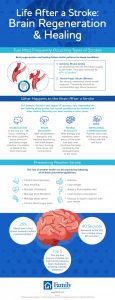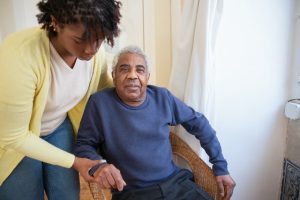By Jim|2025-06-27T10:38:38-05:00July 18th, 2025|News Posts|Comments Off on 7 Steps to Stroke Recovery
Guest Blog: Adjusting to Life After a Stroke
In America, stroke is the third leading cause of death. The brain and heart rely on each other to sustain basic functionality of the human body. The brain controls a large portion of the body’s range of capabilities and nerve signaling. Your brain has multiple purposes, but a single stroke can put those critical functions at risk. Communication, memory, emotional activity, and physical capabilities can all be affected when the brain is not operating at its utmost potential.
Difference Between a Stroke and a Heart Attack
A stroke and a heart attack may seem similar but are very different. Both ailments occur due to a shortage of oxygenated blood and blood flow, except strokes primarily affect the brain while heart attacks mainly target the heart. When the body’s blood flow to the heart is blocked, sometimes due to a blood clot, it can cause a heart attack. A stroke, on the other hand, can cause possible brain tissue to decay and long-term disability or death.
Stroke Causes
The leading cause of strokes is anything that leads to blocked blood supply or a burst blood vessel, cutting off the oxygen flow to the brain. A number of risk factors for a stroke, such as high cholesterol and obesity, can be medically managed or treated. Nevertheless, as with certain terminal conditions, particular risk factors are more challenging to address.
An individual’s lifestyle has a considerable effect on their health. Harmful choices can lead to chronic illnesses with detrimental long-term consequences. Nearly everything that goes into the body has the potential to affect your physical and emotional well-being. For example, eating highly processed fast food can possibly make the person feel groggy and lethargic, while a plant-based diet can help support a healthy immune system.
Controllable risk factors for a stroke are:
- Diabetes
- Lack of exercise
- High blood pressure
- High cholesterol
- Excessive alcohol or drug use
- Smoking
Uncontrollable risk factors include:
- Age: The risk of having a stroke doubles every ten years after the age of fifty-five.
- Race: Black and nonwhite Hispanic Americans are affected more than white Americans.
- Gender: Although strokes occur more regularly in men, women are more prone to suffer one later in life, placing them at higher danger of nonrecovery.
- Family history: Strokes are more likely to occur within families that carry genetic disorders.
Even if someone is taking good care of their body and do not carry any genetic risk factors, they can still be at risk due to:
- Geography: Strokes happen more in southeastern America than in the rest of the country, perhaps due to elements of the regional culture such as diet.
- Climate: Extreme temperatures increase the risk of a stroke.
- Economic and social circumstances: Particular evidence suggests that stroke cases are more prevalent in low-income communities.
Stroke Treatment
To properly treat a stroke, doctors must first determine the causes of the symptoms through a CT scan or other stroke tests. Stroke tests vary from simple physical analysis and blood analysis to more involved procedures such as echocardiograms, cerebral angiograms, MRI scans, or carotid ultrasounds. About a quarter of stroke survivors will suffer a second stroke, making immediate treatment vital.
Some steps to help stroke patients recover include seeking support and therapy, monitoring medications, being on the lookout for dizziness or imbalance, ensuring a healthy diet, and keeping the brain active. It is crucial to remember that recovering from a traumatic brain injury such as a stroke takes time and patience.
Recovery can be a long-term process. Hence, it is imperative to understand how the body and brain are affected. Refer to the following infographic made by Family Home Health Services for further information on brain recovery as well as stroke-prevention practices to incorporate into everyday life.
Guest Blog: Best Ways to Support a Loved One After a Stroke
A stroke is a serious, life-changing event that occurs when the brain becomes cut off from its oxygen supply due to bleeding or a blocked artery. Fortunately, many people are able to regain most of their cognitive function by following the guidance of their doctors, physical therapists, and speech pathologists. If your loved one has recently suffered from a stroke, there are many ways you can help facilitate their recovery and improve their quality of life.
Rebuild Skills Through Stimulation And Repetitive Practicing
While recovering from a stroke can be a long and often frustrating process, it is important to help them stay on track through purposeful stimulation and repetitive practice. Practicing simple daily tasks is necessary for the neural pathways to rebuild efficiently. Even simple, repetitive motions like leg bends and hand exercises are critical if your loved one is to gain full recovery after a stroke.
Help They Stay Consistent With Full Body Exercises
Your loved one’s physical therapist plays a critical role on their path to stroke recovery. They know exactly which exercises to prescribe for their clients in order to address any lasting effects their stroke has had on their mobility and quality of life. If your loved one struggles with walking after a stroke they may be instructed to complete a series of core, leg, and feet exercises to improve their mobility. Be sure to help them practice these moves on a regular basis and provide ample encouragement along the way.
Don’t Underestimate The Healing Power Of Sleep
Sleep is a powerful healer. Studies have shown that those who have experienced a stroke are more likely to regain mobility and improved neuroplasticity if they receive a healthy amount of sleep every night. Subsequently, stroke survivors who struggle with sleep issues such as insomnia, sleep apnea, and restless leg syndrome tend to have poorer recovery outcomes. If your loved one is struggling to get enough sleep after they have suffered a stroke it’s important to let their doctor know so they can get to the root of the underlying issue.
Boost Neurogenesis With A Healthy Diet
Your loved one’s diet can play a huge role in how well they are able to recover from a stroke. Certain types of foods promote healthy brain functioning and neurogenesis. You can help your loved one incorporate these foods into their diet by helping them with their grocery shopping and incorporating foods like fish, fresh berries, and nuts into their diet. Leafy greens, legumes, and whole wheat are also good choices for stroke patients. Be sure to consult their physician before making dietary changes, especially if they also have special restrictions due to diabetes or high blood pressure.
Prevent Regression By Helping Them Maintain Consistency
Recovering from a stroke can be a lengthy and frustrating process, especially since mobility gains are often incremental. This can be disheartening for loved ones who may have lived a very robust and active lifestyle prior to their stroke. Not only is recovery frustrating, but it can also be a lonely experience, especially if your loved one has lost their ability to communicate as well. Try to be as active as possible in their recovery process and provide ample encouragement along the way.
Incorporate Apps Into Their Recovery Treatment Plan
Aphasia is a common condition that affects a person’s ability to understand and communicate and is commonly associated with stroke. Aphasia presents differently in all patients and can be as mild as a speech impediment or as catastrophic as total communication loss. Fortunately, there are inexpensive apps you can download for your loved one that will help them improve their language and cognitive skills. If you’re unsure which apps would be most beneficial you should consult their speech pathologist. They will be most familiar with your loved one’s specific needs and can point you in the right direction.
Closing Thoughts
Although there might be some plateaus along the way, you can help your loved one successfully recover from a stroke. By helping them stay consistent with their exercises and accompanying them to their appointments whenever you can, your loved one has a greater chance of regaining their cognitive abilities and significantly improving their quality of life.


